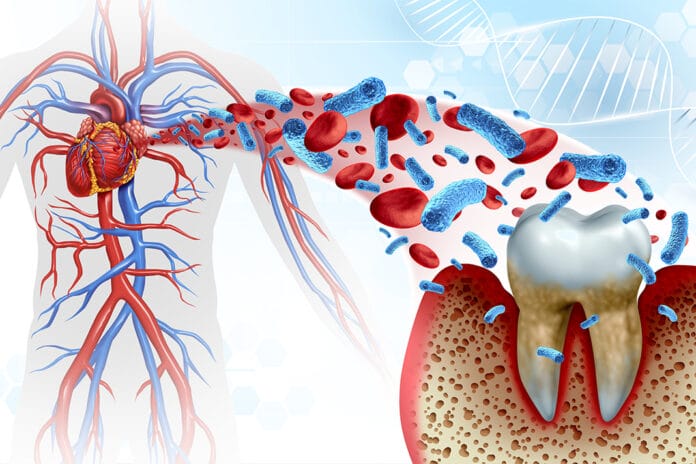According to the American Dental Association (ADA), no gene has been identified that has a large impact on periodontal disease.1 Nonetheless, we see this disease affects families, which would indicate there is some level of genetic factor associated with disease onset and progression. The ADA clearly states environmental influences are the biggest association with periodontal disease, and the connection may be due to gene-environmental interactions.1
With the ever-growing area of genetics and epigenetics, new gene isotypes that play a role in multiple diseases are being identified. Almost every chromosome has the potential to contribute to diseases through single nucleotide polymorphisms (SNPs) as well as other genetic factors. Through genome-wide association studies, scientists have identified many of the SNPs that contribute to disease.
However, more studies are needed to further clarify and identify as many SNPs as possible. This will potentially improve our understanding of disease processes.2
Below is a quick review of the parts of the human genome and what is understood thus far by science and research:2
- Genomes are made of DNA.
- DNA is read like a code using four types of chemical building blocks: adenine, thymine, cytosine, and guanine.
- The code changes slightly to make you who you are; however, approximately 99.9% of your DNA sequence is identical to any other human.
- DNA is divided into several uneven segments known as chromosomes. Humans have 46 chromosomes, while rice plants have 24 and dogs have 78.
- Chromosomes contain genes, a DNA segment with instructions for making specific proteins responsible for specific body functions.
- On average, a human gene will have one to three different coding sequences; this affects eye color, hair, and skin. However, these variations also influence your risk of developing diseases and your responses to medications.
- Humans have approximately 21,000 genes.
- Multiple genes influence most traits.
- Environmental factors such as what you eat, if you smoke, how active you are, or if you get enough sleep influence how your genome works.
The APOE Gene
The APOE gene, found on chromosome 19, provides instructions to the body for making a protein called apolipoprotein E. This protein combines with lipids to make lipoproteins responsible for packaging and carrying cholesterol and other fats through the bloodstream. This protein, when properly functioning, helps maintain normal levels of cholesterol.
When the gene is malfunctioning, there is an increased risk of cardiovascular disease. Additionally, certain SNPs associated with the APOE gene increase the risk of Alzheimer’s disease.3,4
An association between cardiovascular disease and periodontal disease has been well established. This connection is characterized by chronic inflammation and gene-environmental interactions. An SNP in the APOE gene, APOE4, has been recognized as a risk factor for cardiovascular disease and an immunoinflammatory factor. A review published in 2018 aimed to “investigate the potential underlying mechanisms related to APOE4 that could increase the risk of periodontal disease, and ultimately atherosclerosis.”5
The change found in the APOE4 molecule is the presence of arginine in the position where cysteine is found in other APOE genes, allowing a salt bridge between the misplaced arginine and glutamate adjacent to the arginine. This interaction causes an increased affinity for very-low-density lipoprotein (VLDL) instead of the increased affinity for high-density lipoprotein (HDL) found in other APOE gene variations. This is the mechanism by which this SNP increases the risk for cardiovascular disease.5
Other variations of the APOE gene have been identified ‒ APOE1, APOE2, APOE3, APOE5, and APOE7. However, these isotypes have not displayed the same changes associated with the APOE4 SNP.
Of note, people with two copies of APOE2 have an increased risk of developing a rare condition called hyperlipoproteinemia type III. This does increase the risk of cardiovascular disease. However, this is much rarer than the APOE4 SNP. Additionally, only one copy of the APOE4 SNP is needed to increase the risk of cardiovascular disease. An estimated 25% of the population has at least one APOE4 SNP, while the APOE2 gene is only seen in about 7% of the world population.3,5-7
APOE4 as a Risk Factor for Periodontal Disease
Though the connection between the APOE4 SNP and oral disease is largely unexplored, there is a plausible mechanism by which this SNP could contribute to disease onset and progression as well as provide clarity on the connection between periodontal disease and atherosclerosis.
The mechanism proposed in the connection between periodontal disease and atherosclerosis via the APOE4 isotype is the formation of LDL oxidation. The exact mechanism of LDL oxidation is unclear; however, it can be loosely defined as “a particle obtained from circulating LDL that may have peroxides or their degradation products generated with the LDL molecule.”8
LDL oxidation may be accelerated by co-existing chronic inflammatory diseases, such as periodontal disease. The contributing factor may be that monocyte/macrophage activity as it is essential for LDL oxidation.9 Monocyte and/or macrophage activity is well documented in the onset and progression of periodontal disease.5
The link between APOE4, periodontal disease, and atherosclerosis is unexplored and certainly needs more research to identify and define the connection if there is a biological connection. Until then, it is a factor to keep in mind when discussing different contributing factors associated with the oral-systemic link. If you discuss this aspect of the oral-systemic link, it is important to be transparent and advise your patients that it is newly emerging research and no clear causal link has been identified.5
The following graphic depicts the up-to-date, recognized interactions with APOE4 and cardio-metabolic risks (dyslipidemia and Western diet) associated with cardiovascular, Alzheimer’s, and oral diseases.5
Conclusion
Many factors play a role in the onset and progression of disease, including periodontal disease. The oral-systemic link is still being explored, and with better science in the area of genetics and epigenetics, clearer links to causality may be identified. Current evidence does not provide a causal link between many systemic diseases associated with oral health.
However, research is getting us closer to the answer. This is not only exciting in the sense of better treatment and prevention options but also as a way for dental hygienists to better understand the disease process.
Better knowledge of potential factors that contribute to oral disease onset and progression will allow better education for patients to understand their disease. Too often, patients want an explanation that we simply cannot provide due to the lack of current evidence, but that may soon change. I encourage you to stay abreast of the newer research in the area of genetics and epigenetics as it applies to the oral-systemic link. To learn more about epigenetics, visit the National Institutes of Health: Epigenomics.
Before you leave, check out the Today’s RDH self-study CE courses. All courses are peer-reviewed and non-sponsored to focus solely on pure education. Click here now.
Listen to the Today’s RDH Dental Hygiene Podcast Below:
References
- Genetics and Oral Health. (2021, July 13). American Dental Association. https://www.ada.org/en/resources/research/science-and-research-institute/oral-health-topics/genetics-and-oral-health
- Introduction to Genomics. (2019, October 11). NIH: National Human Genome Research Institute. https://www.genome.gov/About-Genomics/Introduction-to-Genomics
- APOE gene. (2021, March 29). MedlinePlus. https://medlineplus.gov/genetics/gene/apoe/
- Moreno-Grau, S., Hernández, I., Heilmann-Heimbach, S., et al. Genome-wide Significant Risk Factors on Chromosome 19 and theAPOELocus. Oncotarget. 2018; 9(37): 24590-24600. https://doi.org/10.18632/oncotarget.25083
- Pereira, L.C., Nascimento, J.C.R., Rêgo, J M.C., et al. Apolipoprotein E, Periodontal Disease and the Risk for Atherosclerosis: A Review.Archives of Oral Biology. 2019;98: 204-212. https://doi.org/10.1016/j.archoralbio.2018.11.009
- Study reveals how APOE4 gene may increase risk for dementia. (2021). National Institute on Aging. https://www.nia.nih.gov/news/study-reveals-how-apoe4-gene-may-increase-risk-dementia
- Husain, M. A., Laurent, B., & Plourde, M. (2021). APOE and Alzheimer’s Disease: From Lipid Transport to Physiopathology and Therapeutics.Frontiers in neuroscience,15, 630502. https://doi.org/10.3389/fnins.2021.630502
- Poznyak, A.V., Nikiforov, N.G., Markin, A.M., et al. Overview of OxLDL and Its Impact on Cardiovascular Health: Focus on Atherosclerosis.Frontiers in Pharmacology. 2021;11: 613780. https://doi.org/10.3389/fphar.2020.613780
- Förstermann, U., Xia, N., Li, H. Roles of Vascular Oxidative Stress and Nitric Oxide in the Pathogenesis of Atherosclerosis. Circulation Research. 2017; 120(4): 713-735. https://doi.org/10.1161/CIRCRESAHA.116.309326












